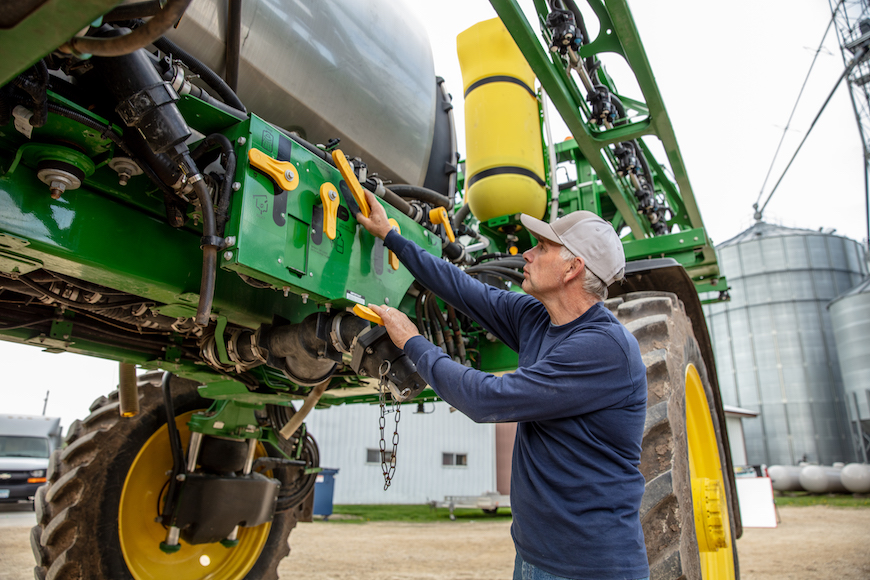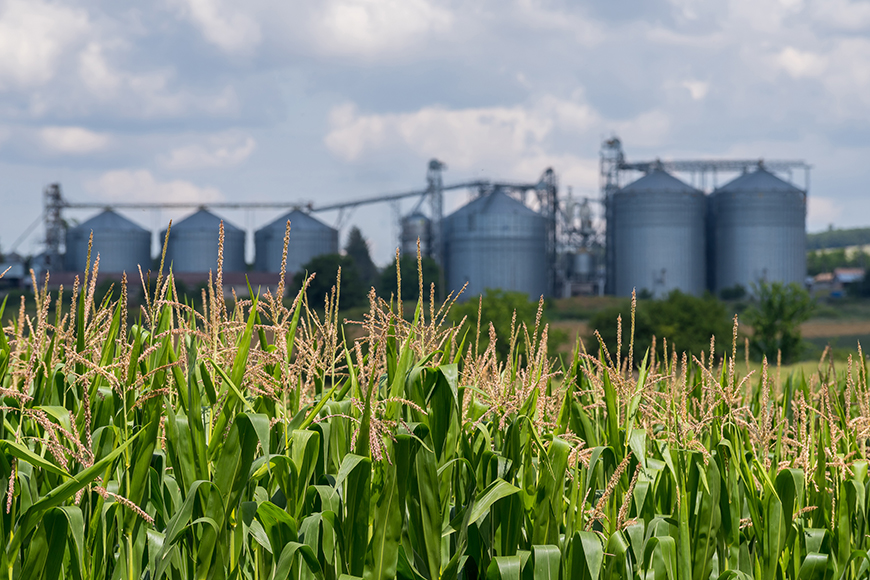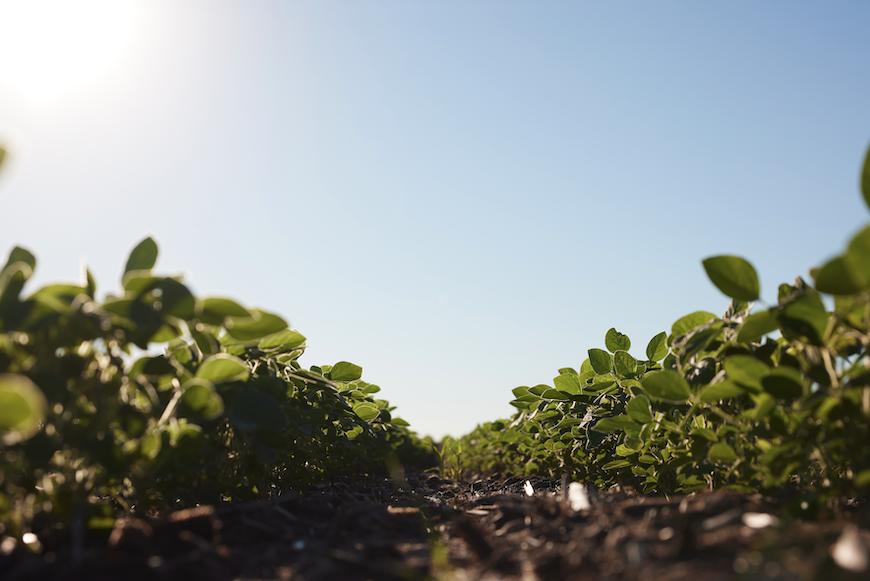Jul 14, 2025
How Late-Season Soybean Treatments Can Impact Yield Potential
Mark Glady
Market Development Agronomist

Mid-July is a critical point in the season. Soybean plants are in the reproductive stages, and your yield potential is not yet locked. My conversations with growers tend to focus on how to protect what’s already in motion and where there’s still room to add on. Fertility, disease and insect pressure are three of the biggest factors that can reduce yield. If managed correctly, they’re also three of the best opportunities to increase your yield potential.
In the upper Midwest, soybeans should be about a third of the way through grain fill by mid-July. It’s an important time to pack nutrients into your plants. You’ve likely gotten good leaf growth, there’s enough canopy and leaf area on the beans to intercept foliar sprays, and you likely have your macronutrients sorted. If that’s the case, my recommendation would be to look at micronutrient nutrition. Specifically, zinc, manganese and boron. Here’s what they offer:
• Zinc is part of the synthesis of auxin, a well-known plant growth hormone, and aids in leaf growth.
• Manganese is essential for photosynthesis in plants and plays a key role in the resistance of plant diseases.
• Boron influences cell development and is essential during reproductive stages.
You don’t need much, fractions of a pound, but if you don’t apply these micronutrients, you could be missing an opportunity to support your top-end yield potential. While soil application can work in some cases, foliar application is often more effective in this instance. If you have spread dry granular fertilizer across your field, you get a granule here and a granule there. They could be several inches to several feet apart, so each plant probably won't have access to it.
Spray droplets will provide more coverage, which is especially important when using a limited amount of product. Most micronutrients are also not very mobile in the plant. They're not going to move up and down. Whatever they touch, they will soak across the leaf and affect the intermediate cellular area.
I recommend using MAX-IN® Ultra ZMB® Plus micronutrient, which combines these three micronutrients into one convenient and effective product. Plus, the CornSorb® technology combines a surfactant and a humectant to deliver 20-50 percent more nutrients into the leaf cuticle.1 The surfactant helps droplets spread and stick to the leaf, while the humectant slows evaporation to give more time for uptake. Roughly a quart per acre is a good option this time of year.
Diseases can destroy or degrade the leaf surface area, reduce photosynthesis and decrease yield. Mid- to late season, the primary diseases to manage are frogeye leaf spot, stem canker and Septoria brown spot. Taking a proactive approach and applying a fungicide before any issues are spotted can help protect and maintain your yield potential.
Now is the time to apply, as it gives your fungicide about a whole month to do its job. It’s a solid opportunity, whether you use a premium, three-mode-of-action fungicide or a two- or single-mode-of-action fungicide, because a fungicide application can also help boost plant health. Plants will stay greener longer, capturing more sunlight, which could lead to more yield.
Occasionally, I hear from growers that they sprayed fungicide, but it didn’t work. So, I’ll ask:
• How much was applied?
• What nozzle did you use?
• What pressure did you use?
• Did you use a deposition aid or an adjuvant?
To achieve sufficient coverage, I recommend applying 15-20 gallons of a fungicide per acre. A knee-high, high-yielding plant usually carries about 15-17 nodes, and nodes 7-12 around the center of the plant tend to play a key role in setting yield potential. If you can't get the fungicide down to the center portion of the plant on those leaves, it can't do its job. To make the most of your investment, you want to ensure the application reaches its target and you coat as much of the leaf as possible.
Including a product like MasterLock® adjuvant in the spray tank can optimize droplet size for reduced drift potential, deeper canopy penetration and better leaf coverage.
I recommend weekly scouting to identify insect pressure and then applying an insecticide accordingly.
Since many insects dwell lower on the plant, it’s important to ensure deposition reaches those shaded, cooler areas. Consider an adjuvant in the tank mix to help ensure deposition deep in the canopy.
Ascend® SL PGR supports cell division and leaf expansion and pairs well with MAX-IN micronutrients. If you're going to stimulate growth through the PGR, we want to ensure we've got the proper nutrition to feed the plants.
Whether it’s micronutrients, fungicides or insecticides, the value of these applications often speaks for itself. When applied correctly, in sufficient amounts and at the right time, they can help manage stress, protect your investment and help push yield potential higher.
Your local CROPLAN retailer can help you develop a late-season strategy tailored to your crop and specific conditions.
1Based on internal research.
All photos are the property of WinField United.
© 2025 WinField United. Important: Before use always read and follow label instructions. Crop performance is dependent on several factors many of which are beyond the control of WinField United, including without limitation, soil type, pest pressures, agronomic practices and weather conditions. Growers are encouraged to consider data from multiple locations, over multiple years and to be mindful of how such agronomic conditions could impact results. Ascend, CornSorb, CROPLAN, MasterLock, Max-In and Ultra ZMB are trademarks of WinField United.
Help Boost Fertility with Micronutrients
Fertility planning and knowing what you need to use when can be confusing, so I like to start with the basics. There are only 17 essential nutrients required to raise a crop. Every grower knows nitrogen, phosphorus and potassium, plus the secondary macronutrients, calcium, magnesium and sulfur.In the upper Midwest, soybeans should be about a third of the way through grain fill by mid-July. It’s an important time to pack nutrients into your plants. You’ve likely gotten good leaf growth, there’s enough canopy and leaf area on the beans to intercept foliar sprays, and you likely have your macronutrients sorted. If that’s the case, my recommendation would be to look at micronutrient nutrition. Specifically, zinc, manganese and boron. Here’s what they offer:
• Zinc is part of the synthesis of auxin, a well-known plant growth hormone, and aids in leaf growth.
• Manganese is essential for photosynthesis in plants and plays a key role in the resistance of plant diseases.
• Boron influences cell development and is essential during reproductive stages.
You don’t need much, fractions of a pound, but if you don’t apply these micronutrients, you could be missing an opportunity to support your top-end yield potential. While soil application can work in some cases, foliar application is often more effective in this instance. If you have spread dry granular fertilizer across your field, you get a granule here and a granule there. They could be several inches to several feet apart, so each plant probably won't have access to it.
Spray droplets will provide more coverage, which is especially important when using a limited amount of product. Most micronutrients are also not very mobile in the plant. They're not going to move up and down. Whatever they touch, they will soak across the leaf and affect the intermediate cellular area.
I recommend using MAX-IN® Ultra ZMB® Plus micronutrient, which combines these three micronutrients into one convenient and effective product. Plus, the CornSorb® technology combines a surfactant and a humectant to deliver 20-50 percent more nutrients into the leaf cuticle.1 The surfactant helps droplets spread and stick to the leaf, while the humectant slows evaporation to give more time for uptake. Roughly a quart per acre is a good option this time of year.
Proactive Fungicides Could Pay Off
Think of the leaf surface area as a solar panel. The more surface area you have, the more sunlight you can capture and the more energy you can produce. Plants follow the same principle. The more leaf surface area a plant has, the more photosynthesis can take place. The plant can then produce more sugar, which in turn could lead to a higher yield.Diseases can destroy or degrade the leaf surface area, reduce photosynthesis and decrease yield. Mid- to late season, the primary diseases to manage are frogeye leaf spot, stem canker and Septoria brown spot. Taking a proactive approach and applying a fungicide before any issues are spotted can help protect and maintain your yield potential.
Now is the time to apply, as it gives your fungicide about a whole month to do its job. It’s a solid opportunity, whether you use a premium, three-mode-of-action fungicide or a two- or single-mode-of-action fungicide, because a fungicide application can also help boost plant health. Plants will stay greener longer, capturing more sunlight, which could lead to more yield.
Occasionally, I hear from growers that they sprayed fungicide, but it didn’t work. So, I’ll ask:
• How much was applied?
• What nozzle did you use?
• What pressure did you use?
• Did you use a deposition aid or an adjuvant?
To achieve sufficient coverage, I recommend applying 15-20 gallons of a fungicide per acre. A knee-high, high-yielding plant usually carries about 15-17 nodes, and nodes 7-12 around the center of the plant tend to play a key role in setting yield potential. If you can't get the fungicide down to the center portion of the plant on those leaves, it can't do its job. To make the most of your investment, you want to ensure the application reaches its target and you coat as much of the leaf as possible.
Including a product like MasterLock® adjuvant in the spray tank can optimize droplet size for reduced drift potential, deeper canopy penetration and better leaf coverage.
Help Protect Foliage from Yield-Robbing Insects
If you have an insect that's chewing and destroying your foliage, it doesn’t take long before it impacts your yield. Even 15-20 percent leaf defoliation can substantially decrease your yield potential.I recommend weekly scouting to identify insect pressure and then applying an insecticide accordingly.
Since many insects dwell lower on the plant, it’s important to ensure deposition reaches those shaded, cooler areas. Consider an adjuvant in the tank mix to help ensure deposition deep in the canopy.
An Add-On to Help Boost Performance
Applying a plant growth regulator (PGR) along with your micronutrient or fungicide can help stimulate growth (such as adding another node or trifoliate) and increase yield potential.Ascend® SL PGR supports cell division and leaf expansion and pairs well with MAX-IN micronutrients. If you're going to stimulate growth through the PGR, we want to ensure we've got the proper nutrition to feed the plants.
Seeing is Believing
Time and again, I hear from growers who skipped a field or left a few acres untreated, only to see a noticeable difference come harvest. Maybe they ran out of product or didn’t want to make a second trip to town. But when that untreated section comes in behind the rest, I usually get the call, “I’m doing it all next year.”Whether it’s micronutrients, fungicides or insecticides, the value of these applications often speaks for itself. When applied correctly, in sufficient amounts and at the right time, they can help manage stress, protect your investment and help push yield potential higher.
Your local CROPLAN retailer can help you develop a late-season strategy tailored to your crop and specific conditions.
1Based on internal research.
All photos are the property of WinField United.
© 2025 WinField United. Important: Before use always read and follow label instructions. Crop performance is dependent on several factors many of which are beyond the control of WinField United, including without limitation, soil type, pest pressures, agronomic practices and weather conditions. Growers are encouraged to consider data from multiple locations, over multiple years and to be mindful of how such agronomic conditions could impact results. Ascend, CornSorb, CROPLAN, MasterLock, Max-In and Ultra ZMB are trademarks of WinField United.
IF YOU LOVE OUR INSIGHT, YOU’LL LOVE OUR ROI POTENTIAL
Every successful harvest starts with a seed. It just can't end there. Choose which high-performing seed products you’ll start with this season.






